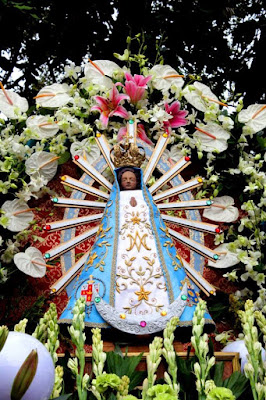Nuestra Señora de Lujan de Caloocan - The Queen of Argentina in the Philippines
 |
| Nuestra Señora de Lujan de Caloocan |
In our recent history, another Marian image from a foreign land also arrived in the Philippine shores, that of Nuestra Señora de Lujan venerated in her humble parish in Caloocan City.
Nuestra Señora de Lujan is widely known as the Queen and Patroness of Argentina and when the Argentine missionaries arrived in Caloocan City, they brought their beloved patroness with them to accompany them in their mission and propagate the devotion to her.
The image
The image of Nuestra Señora de Lujan de Caloocan is a petite image of the Immaculate Conception patterned that of the aforementioned Virgin from Argentina. The image wears a white robe and a blue mantle extending to her feet with the emblems of the Argentine Republic. The Virgin's face is facing directly to the beholder and and her hands are in prayer position. The Virgin wears a crown, she has a crescent moon under her feet and a rafaga the surrounds the Virgin.
 |
| The original image of Nuestra Señora de Lujan of Argentina |
The history of the devotion in Argentina
Tradition holds that a settler ordered the terracotta image of the Immaculate Conception from Brazil in 1630 because he intended to create a shrine in her honor to help reinvigorate the Catholic faith in Santiago del Estero, his region. After embarking from the port of Buenos Aires, the caravan carrying the image stopped at the residence of Don Rosendo Oramas, located in the present town of Zelaya.
When the caravan wanted to resume the journey, the oxen refused to move. Once the crate containing the image was removed, the animals started to move again. Given the evidence of a miracle, people believed the Virgin wished to remain there. The image was venerated in a primitive chapel for 40 years. Then the image was acquired by Ana de Matos and carried to Luján, where it currently resides.
Because of the reputation of the Virgin of Lujan, Pope Leo XIII granted the image the honor of Canonical Coronation in 1886. The papal coronation of Our Lady of Luján took place on May 8, 1887. The celebrant chosen by the Pope for this event was Archbishop Federico León Aneiros who at that time made a pilgrimage in thanksgiving to Our Lady for sparing his archdiocese from the scourge of cholera.
On September 8, 1930, Pope Pius XI formally declared Our Lady of Lujan as the Patroness of Argentina, Paraguay and Uruguay. The Papal document was signed by Cardinal Eugenio Pacelli, the future Pope Pius XII.
 |
| Our Lady of Lujan Parish, Caloocan City |
The arrival of the devotion in the Philippines
The Parish of Our Lady of Lujan was originally dedicated to St. Lutgardis, one of the early mystics of the Church established in 1960 at #56 Malvar Ext. Bagong Barrio Caloocan City. The church was later given to the Religious Family of the Incarnate Word from Argentina in 2009 and it was dedicated to the patroness of the Congregation and their country- Nuestra Señora de Lujan, The parish was established under the Virgin's patronage in 2010.
The Virgin of Lujan was warmly received by the locals and the devotion to the Argentine Queen grew quickly, especially when the Virgin made its first participation at the Grand Marian Procession in Intramuros, Manila in 2015. The Virgin's feast day is celebrated every May 8, or the Second Sunday of May if May 8 fell on a weekday.
The devotion to the Blessed Virgin Mary transcends race, nationality and culture and this was proven several times in our history. This only shows how the Blessed Mother becamea unifying force of all nations, regardless of thier differences in culture. May the Blessed Virgin MAry, the Queen of Peace, help us in this trying times so that we will finally obtain true peace - with her Son as King.
Nuestra Señora de Lujan de Caloocan, pray for us!
References:
"Our Lady of Lujan", Retrieved from http://campus.udayton.edu/mary/resources/engone.html on November 12, 2019.
"Our Lady of Lujan", Our Lady of Lujan Parish, Caloocan City, 2016.
"Our Lady of Lujan Parish" , Retreived from http://kalookandiocese.org/parishes/vicariate-of-the-sacred-heart-of-jesus/birhen-ng-lujan-quasi-parish.html on November 12, 2019.
Special credits to the owners of the photographs of the original image of Our Lady of Lujan of Argentina and Our Lady of Lujan Parish, Caloocan City.
+AM+DG+





I would so like to have a conversation with you regarding your research and the Madonnas whom you are educating us all about
ReplyDeleteHi! How can I help you?
ReplyDeleteThank you so much for responding. I am currently researching Black Madonnas and came across your site, full of information I was unaware of, so thank you very much, this is beautiful work. Could it be possible for us to have a conversation via skype some time in the first week of December, I would like to interview you regarding your work and your sources. Let me know if this is something you are interested in, I am currently in Nevada for the next two weeks. Thanks again!
DeleteHi Stephanie,
DeleteThanks for appreciating my work. Yes, we can set a chat either on Skype or on Facebook, which is a bit easier for me if its ok. We can have a conversation at least on 29 Nov., after thanksgiving or on 7 Dec,, EST. we are currently preparing for the upcoming Grand Marian Procession in Manila this coming 1 Dec., hence the availability dates.
Talk to you soon.
Thanks!
Thanks!